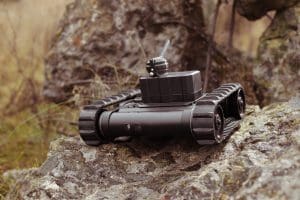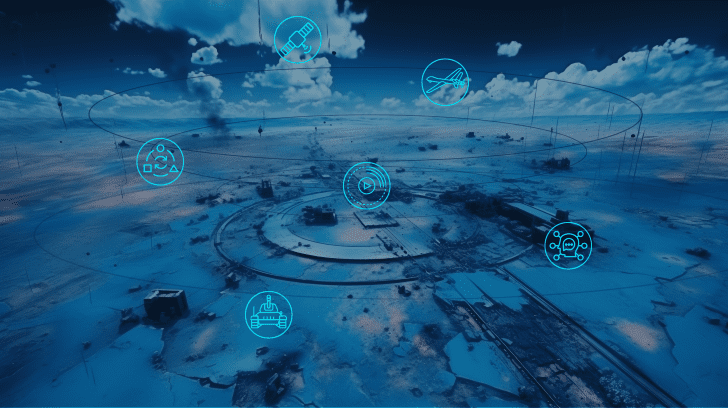The landscape of military technology is undergoing a seismic shift, thanks to the rapid advancement in robotics and autonomous systems (RAS). Today’s RAS are more agile, more intelligent, and capable of executing complex tasks with minimal human intervention. From unmanned aerial vehicles (UAVs) to robotic ground units, these systems are designed for a variety of roles, including logistics support, reconnaissance, and direct combat roles. The integration of artificial intelligence (AI) has further enhanced their capabilities, enabling autonomous decision-making in real-time and adaptability to dynamic combat environments. AI Edge Computing technologies are playing a significant role in this transformation.
These advancements are not just changing how wars are fought but are also opening up new markets and opportunities within the defense sector. Maris Tech, a trailblazer in high-tech defense solutions, is playing a pivotal role in this transformation, bringing innovative solutions to the forefront. This blog explores the burgeoning market of military RAS, spotlighting Maris Tech’s contributions and the groundbreaking technologies reshaping modern warfare, including Intelligent Video Analysis and Intelligent Video Surveillance solutions.
Emerging Markets in Military RAS (Robotics and Autonomous Systems)
The expanding capabilities of military RAS are bringing fresh perspectives and Edge Video Intelligence Solutions to the field, fueling rapid advancements and competition. The market is not just limited to large-scale defense projects; it also encompasses small, modular systems tailored for specific tactical applications. This diversification is not only enhancing the capabilities of armed forces but is also driving down costs, making advanced military technologies more accessible. Let’s explore these markets:
Innovations in Unmanned Aerial Vehicles (UAVs): A well-known segment within military RAS, UAVs, commonly known as drones, have evolved from reconnaissance platforms to versatile units capable of carrying out precision strikes. Embedded Video Processing and AI Video Analysis technologies have been pivotal in this evolution. Over 90 countries now possess some form of military UAV capability, with tens of thousands of UAVs in operation worldwide. The potential is huge with Fortune Business stating that the global military drone market was valued at $12.55 billion in 2022 and is projected to grow to $35.60 billion by 2030, at a CAGR of 14%. Maris Tech has been instrumental in enhancing UAV capabilities with its Low Latency Live Streaming and Ultra-Low Latency Video Streaming technologies.
Advancing Unmanned Ground Vehicles (UGVs): These robotic systems are designed to assist or replace soldiers in dangerous tasks like bomb disposal or reconnaissance in hostile territories, with growing capabilities in autonomous patrolling and combat roles due to AI integration. Low Delay Streaming and Auto-Low Latency Mode technologies have significantly improved the operational efficiency of these units. There are over 15,000 UGVs in service globally, particularly for border patrol and counter-insurgency operations, and that number is expected to reach 40,000 by 2030. Recognizing the potential of UGVs in modern combat, Maris Tech has developed robust communication and control systems, incorporating Intelligent Video Analytics Solutions to enhance their applications in surveillance and logistics.

Pioneering Autonomous Naval Systems: The maritime domain is seeing increased use of autonomous systems. These systems are used for mine countermeasures, anti-submarine warfare, oceanographic mapping, and intelligence gathering. Navies all over the world have begun integrating autonomous systems into their fleets, focusing on enhancing coastal surveillance and undersea warfare capabilities. The market for autonomous underwater vehicles is expected to grow from $1.84 billion in 2023 to $6.81 billion by 2031. Maris Tech’s AI Edge technology enhances unmanned surface and underwater vehicles, facilitating advanced roles in mine countermeasures and anti-submarine warfare.
Redefining Robotic Combat Systems: The global market for robotic warfare was estimated to be worth $29.3 billion in 2023 and is poised to reach $39.5 billion by 2028. This market includes robotic combat vehicles and other defense robotics technologies. Firms are developing RAS capable of more direct combat roles, including fire support, reconnaissance, and logistics in combat zones. Maris Tech is at the forefront of developing sophisticated control systems for robotic combat units. Their focus on reliable and secure communication systems, bolstered by Low Latency technologies, is crucial in ensuring the effectiveness of these remotely controlled combat vehicles.
AI-Driven Intelligence Systems: Used for predictive maintenance, threat identification, surveillance, and reconnaissance, AI systems are crucial in processing and analyzing vast datasets for actionable military intelligence. Video Content Analysis plays a significant role in this arena. Much of military R&D is now directed towards AI and machine learning technologies, indicating a significant shift towards data-driven warfare. In fact, AI in the military market is estimated to be more than $9 billion in 2023 and is projected to reach more than 38 billion by 2028. Maris Tech’s prowess in AI technology has resulted in their systems being adept at processing and analyzing vast datasets, providing critical insights for military decision-making.
Conclusion
Looking ahead, the trajectory of military robotics and autonomous systems is set to continue its upward trend. We can anticipate further integration of AI, especially AI Edge computing, enhancing the autonomy and decision-making capabilities of these systems. Another emerging trend is the development of collaborative systems, where manned and unmanned platforms operate in tandem, leveraging the strengths of both. Additionally, the cross-over of military technologies into civilian applications, such as search and rescue operations and disaster response, is a potential area of growth, blurring the lines between military and civilian technologies.
Maris Tech’s journey in the military robotics and autonomous systems market exemplifies innovation and excellence. Their contributions are shaping the future of warfare, enhancing the capabilities of defense forces worldwide. As these Ultra-Low Latency Video Streaming technologies evolve, Maris Tech remains at the forefront, committed to advancing the potential of RAS in both military and civilian spheres.


